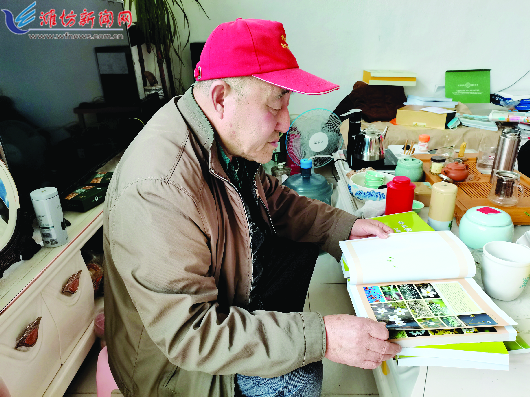
Zhu Ruixiang shows the plant atlas he photographed.
Zhu Ruixiang, 80, is an ordinary farmer in Anqiu and an amateur photographer who likes to photograph plants. For more than 20 years, he has trekked through mountains and rivers to photograph the "lifetime" of nearly 2,000 species of plants, including every detail of leaves, stems, fruits, flowers, and the characteristics of each plant at different growth stages.
I go out to shoot almost every day
Recently, at zhu Ruixiang's home in Xing'an Street, Anqiu City, he enthusiastically showed reporters various photos of plants taken. Zhu Ruixiang has been interested in plants since he was a child, and when he was young, he began to play with the camera, he liked to take pictures of the flowers and grasses around him, and once when he was sorting out pictures, he suddenly had the idea of photographing all the plants in Anqiu. Although a little crazy, the persistent Zhu Ruixiang set off with his film camera on his back.
Zhu Ruixiang said that he has two ways to shoot plants: one is a random shooting without a goal, where to shoot, and then look for plant names, characteristics, etc. from the "Flora" or the Internet after shooting; the other is to look for and shoot purposefully according to the list of books related to Anqiu plants, because the plant list only records the approximate distribution area, he generally has to look around.
Zhu Ruixiang photographed plants not only once, but to photograph the "life" of plants, including leaves, stems, fruits, flowers, overall shapes and growth states in different periods, so for the same plant, he had to shoot many times. If the shooting effect is not ideal, it will be waited until the same time of the next year to reshoot.
As long as it doesn't rain, Zhu Ruixiang will go out to shoot with a camera on his back almost every day. The process of filming is the process of his continuous discovery of the "New World". In 2013, he went to Qingyun Mountain Park to photograph the flower spikes of tall fescue, and on the way back, he accidentally found a small white flower, mixed in the dog's tooth root grass, he took a few photos casually, and went home to inquire to learn that it was white flower ghost needle grass. This was the first time he had seen the flower and regretted not photographing it in detail. Worried that the plant would be gone the next day, he immediately went back to photograph it, and when he returned home again, it was already dark. "I also learned a lesson, and when I find new ones that I haven't photographed in the future, I must observe carefully and try to take as many pictures as possible." Zhu Ruixiang said.
The collation of the book has great reference value
In July 2014, Zhu Ruixiang's family grew several small grasses in the pots, and the small leaves were very beautiful. Later, when fruit bears fruit, the calyx is enclosed in a cylinder with several brown seeds inside. "I don't know what its name is, but it bears fruit before it blooms." Zhu Ruixiang wondered, is it a blossom at night? He simply did not sleep all night and waited for the flowers to bloom. Watching the buds straighten out, the calyx slightly open and closed, or there is no shadow of petals. The next morning, he collected a lot of information according to the general shape of the plant, and finally found this plant in the "Caryophyllaceae, Multiplicium genus"—no petals, no petals.
In addition to the park, most of the plants like to grow at the water's edge and in the mountains, so Zhu Ruixiang walks along the creek or drills in the mountains. Once, he carried a picture of a sumac tree copied from "Anqiu Ancient Famous Tree" to Anqiu Wulong Mountain to take a picture of sumac trees. Led by a guide, Zhu Ruixiang drilled into the woods and weeded the grass, climbed over two hills, climbed hundreds of stone ladders, climbed a steep slope diagonally, stopped at the top of a slightly gentler hill, and pointed to the opposite hillside and said, "That is the sumac tree."
Zhu Ruixiang visually measured it, about 60 meters away. "It's not far, but it's separated by a deep ditch, and the ditch is flanked by slopes, and the potholes under the feet are unpredictable, and if you step on the air, you will have to roll down a deep ditch of tens of meters." Zhu Ruixiang said that at that time, the guide advised him to shoot with a long lens, but he gritted his teeth and decided to shoot it. He hung two cameras around his neck, used both hands and feet, grabbed stones, tugged at tree roots, and trembled, but at the end he took the picture he wanted.
After more than 20 years, Zhu Ruixiang photographed the entire growth process of nearly 2,000 plants in Anqiu and compiled it into the "Anqiu Plant Atlas", which provided a popular and interesting book for primary and secondary school students, and also had great reference value for related research.